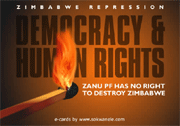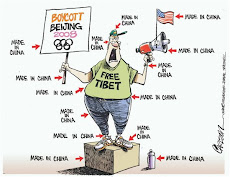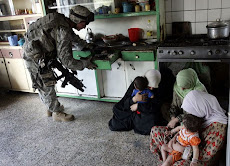 Hawar Omar Muhammad was among the Suleia residents terrorized by the militias, known as the janjaweed, and bombs dropped by government planes. (Lynsey Addario for The New York Times)SULEIA, Sudan: Mar. 2nd. (NY Times)
Hawar Omar Muhammad was among the Suleia residents terrorized by the militias, known as the janjaweed, and bombs dropped by government planes. (Lynsey Addario for The New York Times)SULEIA, Sudan: Mar. 2nd. (NY Times) — They came to this dusty town in the Darfur
region of Sudan on horses and camels on market day. Almost everybody was in the bustling square. At the first clatter of automatic gunfire, everyone ran. The militiamen laid waste to the town — burning huts, pillaging shops, carrying off any loot they could find and shooting anyone who stood in their way, residents said. Asha Abdullah Abakar, wizened and twice widowed, described how she hid in a hut, praying it would not be set on fire. “I have never been so afraid,” she said. The attacks by the janjaweed, the fearsome Arab militias that came three weeks ago, accompanied by government bombers and followed by the Sudanese Army, were a return to the tactics that terrorized Darfur in the early, bloodiest stages of the conflict. Such brutal, three-pronged attacks of this scale — involving close coordination of air power, army troops and Arab militias in areas where rebel troops have been — have rarely been seen in the past few years, when the violence became more episodic and fractured. But they resemble the kinds of campaigns that first captured the world’s attention and prompted the Bush administration to call the violence in Darfur genocide. Aid workers, diplomats and analysts say the return of such attacks is an ominous sign that the fighting in Darfur, which has grown more complex and confusing as it has stretched on for five years, is entering a new and deadly phase — one in which the government is planning a scorched-earth campaign against the rebel groups fighting here as efforts to find a negotiated peace founder.
The government has carried out a series of coordinated attacks in recent weeks, using air power, ground forces and, according to witnesses and peacekeepers stationed in the area, the janjaweed, as their allied militias are known here. The offensives are aimed at retaking ground gained by a rebel group, the Justice and Equality Movement, which has been gathering strength and has close ties to the government of neighboring Chad. Government officials say that their strikes have been carefully devised to hit the rebels, not civilians, and that Arab militias were not involved. They said they had been motivated to evict the rebels in part because the rebels were hijacking aid vehicles and preventing peacekeepers from patrolling the area, events that some aid workers and peacekeepers confirmed. “We are simply trying to secure the area from the bandits that are troubling civilians in the area,” said Ali al-Sadig, a government spokesman. “There is nothing abnormal about a government doing this.” But residents of the towns said the rebels had been long gone by the time the government attacks began, leaving defenseless civilians to flee bombs and guns. In interviews, survivors of the attacks described a series of assaults that had left dozens dead, turned large sections of towns into hut-shaped circles of ash and scattered tens of thousands of fearful residents, including hundreds of children, who fled classrooms in the middle of a school day and have not been reunited with their families. “My son Ahmed, he ran, but I have not seen him since,” said a woman named Aisha as she waited for a sack of sorghum from UN workers in Sirba, one of the towns that was attacked. “I just pray he is still hiding in the bush somewhere and will come back to me.” 
The United Nations estimates that the recent fighting has forced about 45,000 people to flee their homes in Darfur, which is roughly the size of Texas and has a population of about six million people. Some fled to Chad, where they have not been able to reach the safety of refugee camps because of continued bombing along the border. Others fled to Jebel Moun, a rebel stronghold to the east, and aid workers fear for the safety of about 20,000 people who are in the path of future attacks if the government presses ahead with its offensive and the rebels vow to resist. Military officials from the peacekeeping force in Darfur said in recent days that the Sudanese military had added nearly a brigade of troops to West Darfur, along with two dozen tanks and armored vehicles and many heavy weapons. “You see a buildup from both sides,” said Ameerah Haq, the senior United Nations aid official in Sudan. “Both sides must desist. We have a population that is just being attacked and hit from both sides.”
Pressure is mounting on Sudan over Darfur. In January, a long-sought hybrid United Nations and African Union peacekeeping force began working in Darfur, but the Sudanese government’s quibbling over which countries the troops will come from and bureaucratic delays have stalled the force’s deployment. Sudan’s biggest trading partner and ally, China, has also come under pressure from advocates who have linked the Olympic Games in Beijing this summer to the fighting in Darfur. China has been more publicly critical of the Sudanese government in recent weeks. Sudan has also been trying to improve its relationship with the United States, and last week, President Bush’s new special envoy to Sudan, Richard S. Williamson, visited Darfur and the Sudanese capital, Khartoum, meeting with President Omar al-Bashir. Any improvement in relations, he said, would be contingent on tangible improvements in the humanitarian situation. “Since the first of the year another 75,000 people in Darfur have been displaced,” Mr. Williamson said in a telephone interview. “That is more than a thousand a day. There are not going to be any changes until that reverses.”
Despite the pressure, the government seems determined to fight on, and the most powerful rebel groups — the biggest factions of the Justice and Equality Movement and the Sudanese Liberation Army — have refused to sit down for talks. So the violence continues, tracing a familiar arc as it wears on. It was five years ago last week that an attack by rebels from non-Arab tribes like the Fur, Masalit and Zaghawa, seeking greater wealth and autonomy for the neglected and impoverished region of Darfur, prompted the Arab-dominated government to marshal Arab militias in the region that ultimately evicted millions from their homes, burning, looting and raping along the way. The campaign effectively pushed many non-Arab people off their land and into vast, squalid camps across Darfur and Chad. In the first two years of the conflict, 2003 and 2004, joint attacks by the Sudanese Army, janjaweed militiamen and the government’s old Russian-made Antonov bombers terrorized Darfur, waging a brutal counterinsurgency against non-Arab rebel groups by attacking their fellow tribesmen in their villages. At least 200,000 are believed to have died as a result of the violence or sickness and hunger caused by the crisis, according to international estimates, with the majority of violent deaths in that period. But in the past two years, the conflict has grown more complex and chaotic, and while some coordinated attacks by janjaweed militias and aerial bombardment have occurred, they were not of the same scale or intensity. But Darfur has remained a deadly place.
In 2006, before a peace agreement and then in the aftermath of its failure, rebel groups fractured and began fighting among themselves. Hundreds of thousands of people were displaced and hundreds died as a result of their battles. Today, according to some estimates, two dozen rebel groups are jockeying for territory and influence in Darfur. Some analysts and human rights workers say the government has sown chaos by splintering the rebel groups to weaken them. In 2007, Arab tribes, some of which had allied with the government and some of which had taken up arms to fight the rebels, also began to fight one another. Many of the violent deaths of 2007 were caused by these bloody battles between Arab groups and their militias, according to aid workers and diplomats in the region. But as the conflict enters its sixth year, an older, deadly pattern is returning, and with it fears are rising among villagers, aid workers, diplomats and analysts that Darfur is headed for a new cycle of bloodletting and displacement on a vast scale.
In recent weeks, bombs dropped from government planes hit Abu Surouj, Sirba, Suleia and other towns in West Darfur, then came janjaweed militiamen, who killed, raped and burned, helping themselves to livestock and grain, furniture and clothing. In one town, the raiders pried the corrugated metal roof off a school, aid workers said. In another, water pumps were destroyed. “This is the kind of destruction that makes it hard for people to return,” said Ted Chaiban, the Unicef representative in Sudan, who has toured the area of the attacks. “People need security. They are totally vulnerable.”
The recent violence in Chad, where rebel groups with bases in Sudan tried to topple the government in early February, has worsened matters. Rebels in Darfur, who diplomats and analysts say have received arms and cash from the family of Chad’s president, Idriss Déby, rushed into Chad to help defend him, creating a vacuum in the territory they had occupied. Sudan’s government seized the opportunity to retake the ground and now appears to be pushing farther into areas long held by the rebels, according to peacekeepers stationed here. Few people in the region were unhappy to see the Justice and Equality Movement evicted. Banditry was rife in the territory it controlled, and for months aid groups had dodged carjackings and other attacks. African Union peacekeepers had been barred from the area, according to Brig. Gen. Balla Keita, the new regional commander of the hybrid United Nations-African Union force in West Darfur. "They were causing a lot of insecurity," General Keita said of the rebels, but he added that this did not justify attacks on heavily populated areas. In Suleia, only a few hundred residents remained of the 15,000 who had lived here. Those left behind were too weak to run and have sought safety near the army camp at the edge of town, sleeping in the open, huddled together for warmth against the frigid night winds. The Sudanese soldiers here have promised to protect them from militiamen who still roam the edges of town. They prevented militiamen from stealing sacks of grain delivered by aid groups, residents said. Adam Adoum Abdullah, a former rebel fighter who joined the Sudanese Army as part of a peace deal with one rebel group in 2006, commandeered an army truck to help collect what little food, blankets and bits of shelter remained in the town for those sleeping out in the cold next to the army camp. “I am ashamed that the janjaweed come with the soldiers,” Mr. Abdullah said. “What kind of army are we to fight like this? These people, they are suffering. We must help them.”
By Lydia Polgreen
++++++++++++++++++++++++++++++++++++++++++++++++++
Disclaimer
No responsibility or liability shall attach itself to either myself or to the blogspot ‘Mozlink’ for any or all of the articles/images placed here. The placing of an article does not necessarily imply that I agree or accept the contents of the article as being necessarily factual in theology, dogma or otherwise.
Mozlink




























































